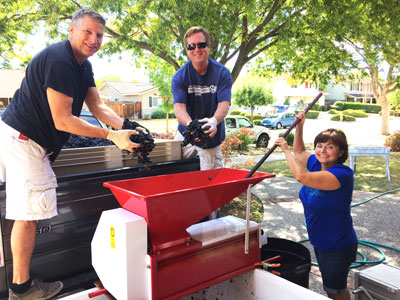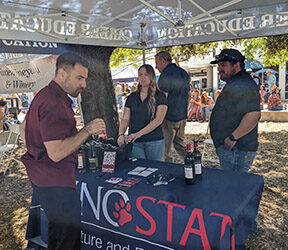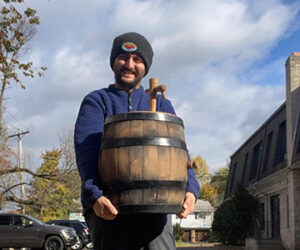 Stan inches his forklift towards the back of my truck and then guides the raised bin forward and expertly lowers it down between the wheel wells. The bed of the truck drops from the weight of a half-ton of Zinfandel grapes. Stan then loads another bin into the back of Tom’s truck. On this beautiful, September morning my wife and I begin our 22nd vintage as home winemakers. Joining us are friends who have made wine with us these past few years. After tying down the bins, I wash my hands with a garden hose and cut Stan a check. We call the kids who are in the vineyard munching on grapes. Climbing into our trucks our caravan winds through the backroads from Morgan Hill, California to my house.
Stan inches his forklift towards the back of my truck and then guides the raised bin forward and expertly lowers it down between the wheel wells. The bed of the truck drops from the weight of a half-ton of Zinfandel grapes. Stan then loads another bin into the back of Tom’s truck. On this beautiful, September morning my wife and I begin our 22nd vintage as home winemakers. Joining us are friends who have made wine with us these past few years. After tying down the bins, I wash my hands with a garden hose and cut Stan a check. We call the kids who are in the vineyard munching on grapes. Climbing into our trucks our caravan winds through the backroads from Morgan Hill, California to my house.
Thirty minutes later I back the truck into my driveway while Tom parks under the shade of a tree. The crusher/destemmer sits atop an empty bin in front of the garage as I back up within inches of it. Bob and Lisa climb up into the bed, turn on the crusher and begin bucketing grapes.
Our neighbors recognize the noise and come over to watch the fun. Someone makes a run for burritos and beer. Elizabeth takes photos to document this year’s activities. Halfway through the crush the kids find the wine thief and fill cups with grape juice. Bees like grape juice too and fly like kamikazes into the must.
As soon as enough juice collects in the bin, Addison takes both sugar and acid readings. Peering at the hydrometer the brix is 25 and everyone lets out a cheer. The acids are within range according to the pH meter. We collect a sample to send off to a wine lab for more definitive testing. Sulfites are added to kill the wild yeasts and so is dry ice to initiate our version of a cold-soak fermentation. In a few days we will add our preferred yeast strain along with other nutrients, and once fermentation starts we will add the ML bacteria to get the secondary fermentation into gear.
The crush goes quickly and clean up begins. We put the lids on the two bins to cover the must. If fermentation goes as planned, we will press the following week. In a few days the yeast will start converting the sugars to ethanol and carbon dioxide. The pool of liquid will sink under a rising cap of decaying grape skins pushed up by the CO2, and I will punch down three times a day. Lunch arrives and we follow the proverb that it takes a lot of beer to make good wine. We lounge around in lawn chairs basking in the day’s accomplishment.
Later that evening my wife and I sit in our backyard and enjoy the night with a bottle of wine. In my neighborhood, across California, and around the world in grape-growing localities, fresh-grape winemakers create wine because they have access to grapes. We may not always have access to the enchantment of certain modern technologies, but we’re empowered with crushers and presses and we use stainless and oak to create our own magic.
Each year we enter our wines in home winemaker competitions like the California State Fair, and if they earn gold, we feel validation for our efforts. Like commercial winemakers, we depend on Mother Nature and rely on science, art and a bit of luck. We don’t make wine for a living but for the love of the activity and because we can. Winemaking is about connections: To the earth, to community, to history. Tonight, I ponder the future of this year’s Zinfandel while proudly embracing this moment with stained hands, a strained back, and the sensory satisfaction of a good glass of vino de casa.






